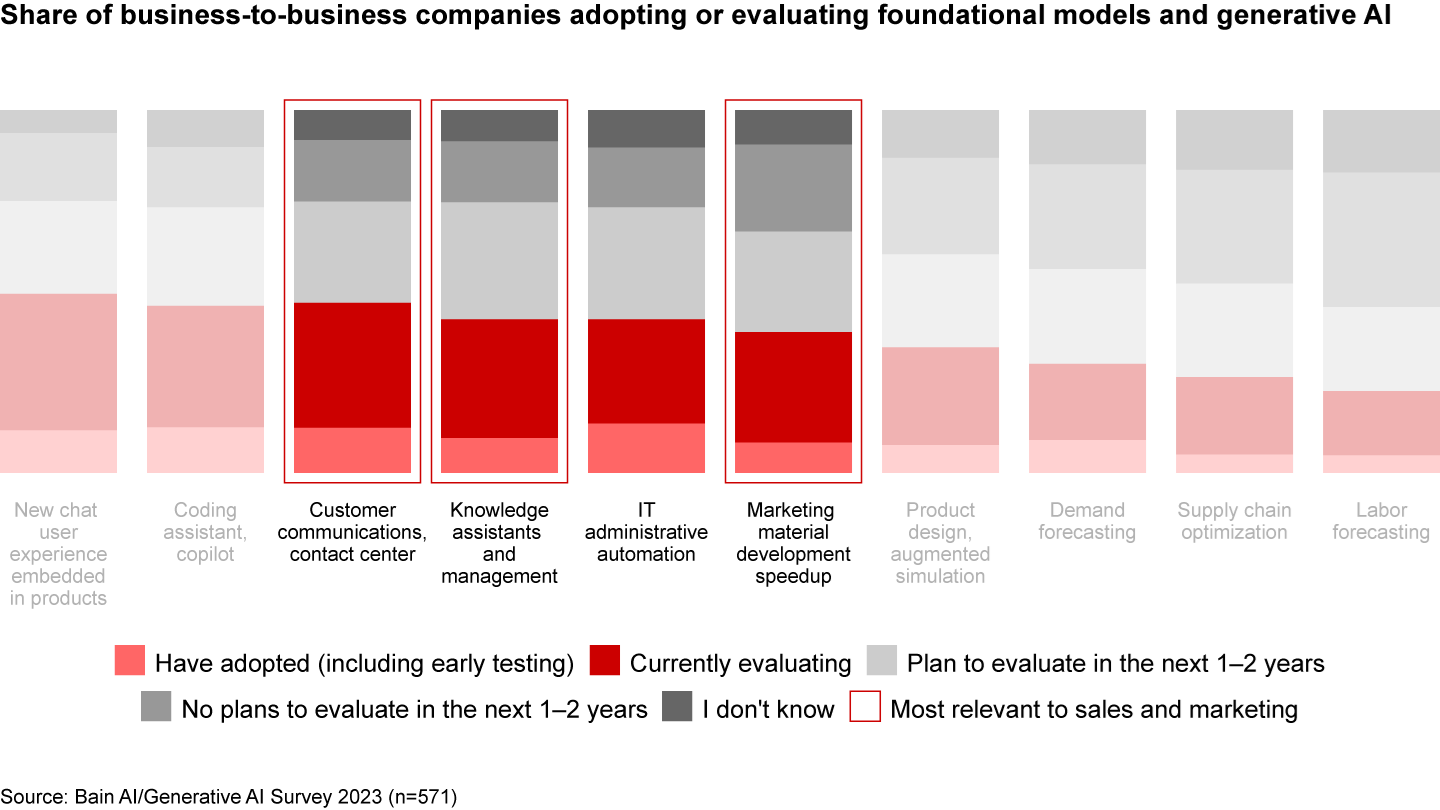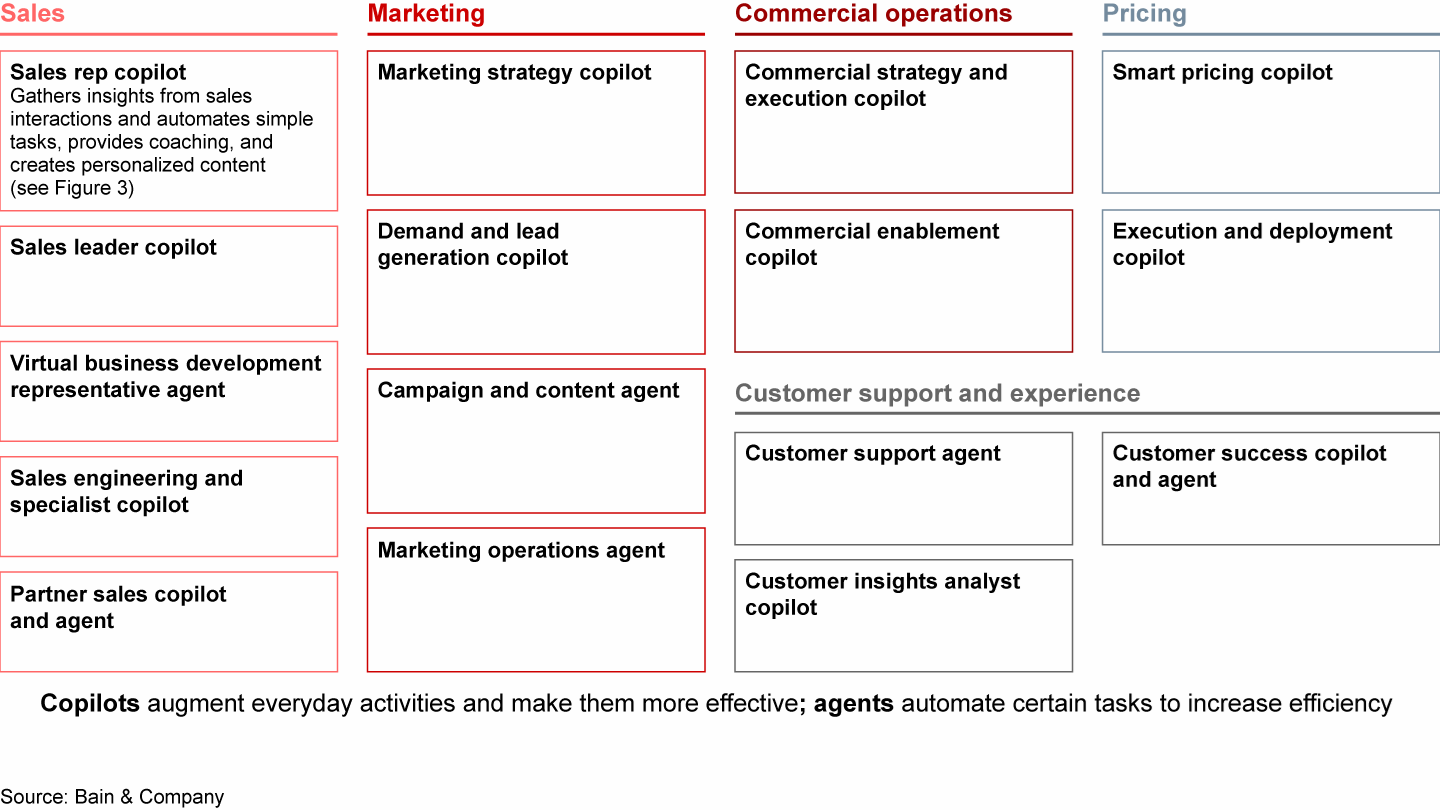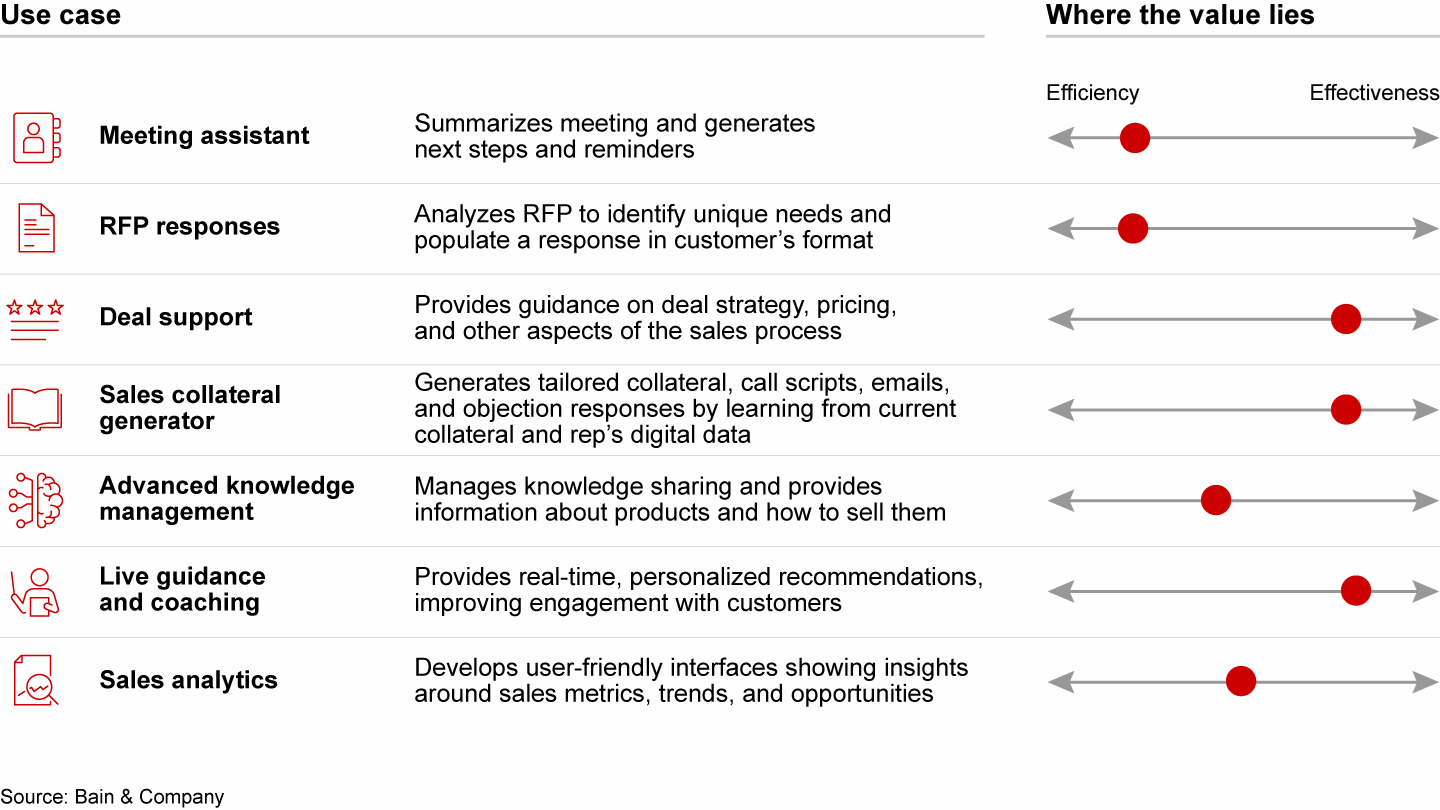Brief

At a Glance
- In business-to-business markets, sales and marketing will be among the first functions to become transformed by generative AI, with roughly 40% of companies already adopting or evaluating the technology.
- Because generative AI enables on the order of 10 times more use cases than previous generations of AI, choosing high-priority use cases is critical yet more difficult.
- To that end, an effective approach is to reduce the number of application areas to a few promising solution “packages” that make optimal use of data and technology.
- Since the technology is ready and available today, early adopters with effective change management plans will gain a competitive edge.
As companies experiment with generative artificial intelligence (AI), sales and marketing in business-to-business (B2B) markets will be among the first functions to use the technology in major, even transformative ways. A recent Bain & Company survey of more than 550 enterprises worldwide shows that use cases in sales, marketing, and customer support are among those getting the most uptake (see Figure 1). Roughly 40% of respondents have adopted or are evaluating the technology.
Foundational models and generative AI have the highest potential in sales, marketing, and customer support


What accounts for the rapid uptake of generative AI in the go-to-market arena? Sales and marketing organizations rely heavily on unstructured text and general reasoning, which plays to generative AI’s core strengths. For example:
- Autonomous agents can qualify leads by sending automated emails, mining both prospect information and a repository of content.
- A sales representative can call on a virtual copilot that has access to a library of internal and competitor product specifications, increasing depth and breadth of product expertise.
- Reps can automate manual tasks such as creating requests for proposals (RFPs), and generative AI can complete responses by referencing winning RFPs.
- Automated collateral generators can personalize content in seconds, building on customer and product information to tailor each message.
These use cases help to unlock sales and marketing productivity, allowing a company to grow faster without driving up costs. The technology will transform B-level sales reps into A-players and make A-players even better, all while greatly accelerating the time to complete administrative activities.
So many potential use cases, so little time
Generative AI models enable new capabilities and can be used more readily by a wider array of people. Because they are pre-trained on Internet-scale data, generative AI models are also able to “learn” how to perform many tasks and require less additional data than earlier generations of AI to translate learnings to a company’s specific application. As a result, generative AI enables on the order of 10 times more use cases. Selecting high-priority use cases thus becomes more important yet more difficult, which means companies need a way to do this quickly yet strategically.
Logically, prioritization should start with the role, then the use case. Starting with the role ensures that the effort connects to a measurable effect, such as sales rep productivity. Otherwise, one risks choosing use cases or tasks that individually seem valuable, but together have diffuse results.
A two-step approach can be effective here. First, group use cases into solution “packages” and choose two to four packages, each containing 5 to 10 use cases, to focus on (see Figure 2).
Companies can group use cases into solution packages


A solution package is a group of use cases that either automate or augment a given role in the organization. For example, a “sales rep copilot” solution package might gather insights from sales interactions and automate simple tasks, provide coaching, and create personalized content. Use cases contained in this package could include a meeting assistant, a sales collateral generator, and live guidance (see Figure 3).
The sales rep copilot solution package consists of at least seven use cases


Next, within each package, prioritize the use cases according to the most important business objective (efficiency or effectiveness), time to realize value, the organization’s ability to deploy them, and the risks involved. This approach limits the changes needed to a smaller group of people. It also creates data assets that can be repurposed for other use cases within the same domain, allowing for a fast follow-up and thereby compounding the value of each package.
To the early adopters go the spoils
B2B companies using generative AI are already seeing the initial benefits of customization, speed, and efficiency. In our experience, the time to develop a proof of concept is half that of traditional AI, partly because generative AI requires less data, and thus can produce value in more places more quickly.
Early adopters, then, might be able to create an insurmountable advantage. Fast deployment and the ability to reinvest savings will make it difficult for laggards to catch up.
Despite the promise of generative AI, many sales and marketing organizations are not pursuing the opportunity aggressively enough. Some believe they should wait until the technology is proven and they’ve brought experts on board. Others think that the technology is not ready for enterprise applications or believe they can wait because the initial AI technologies took nearly a decade to play out. And many who might be convinced don’t know where to start.
Yet waiting is a mistake. The technology is better and easier than one might think—and well suited for enterprise applications. Even today, it’s robust, cheap, and accessible. Design patterns exist that reduce the much-publicized “hallucination,” though human checks remain important. Vendors in this space have already created more than 20 off-the-shelf use cases in the first half of 2023 and are building many more.
As with any new tool, humans will still be involved, so effective change management will be critical to encouraging adoption and thereby reaping value. Getting sales reps, marketers, and others comfortable using the technology will take time, but it will make them considerably more productive.
Moreover, the prospect of greater efficiencies can cause employees to worry about their jobs and actively resist adoption. Relieving their anxieties and encouraging adoption of the technology will be critical to reaping value, but this requires thoughtful, empathetic management. Companies that find the greatest success with generative AI will be those that master not only the technical capabilities but also the behavioral changes inherent to this shift in how people work.